Complex patients benefit from expert dosimetry teams

Identification of optimal dosing for multifocal cancers or cancers around sensitive organs can prove difficult for cancer treatment teams, whose ideal approach balances tumor lysing with healthy tissue sparing.
Advertisement
Cleveland Clinic is a non-profit academic medical center. Advertising on our site helps support our mission. We do not endorse non-Cleveland Clinic products or services. Policy
Such was the case of a recent bilateral breast cancer patient, whose trimodality treatment necessitated radiation around the sternum, heart and lungs.
The patient is a 54-year-old female who presented with bilateral breast-infiltrating ductal carcinoma with 1.3 cm mass in the right breast and 3.4 cm mass in the left breast. Treatment included radiation, in addition to neoadjuvant chemotherapy with trastuzumab, pertuzumab, docetaxol and carboplatin. After chemotherapy, she underwent bilateral mastectomies with expander reconstruction.
“Like many of the more difficult cases we see, this patient posed a challenge in that our treatment team was committed to curing her cancer while also positioning her for the most fulfilling life possible after she walked out the door,” says Ping Xia, PhD, head of Medical Physics in the Department of Radiation Oncology.
Senior medical dosimetrist Eric Murray, under guidance of Dr. Xia, designed the following radiation treatment plan, which minimized exposure to critical organs while maximizing therapeutic effect:

This planning CT scan of a bilateral breast cancer patient shows radiation exposure levels and was designed by the Medical Dosimetry team at Cleveland Clinic. At the time of publication, the patient remains disease free with fully functional organs.

As oncology moves toward treating the entire patient, including quality-of-life considerations and overall wellness after treatment, treatment planning in dosimetry has emerged as an important piece of the treatment puzzle.
Advertisement
Patients and treatment teams rely on radiation oncologists, physicists and dosimetrists to craft individualized therapeutic plans that deliver favorable outcomes measured not only by disease-free survival but also by overall patient health and wellness.
In challenging cases, such as bilateral breast, head and neck, brain and other malignancies arising in sensitive areas, dosimetry teams are positioned to serve as critical participants in the treatment planning process.
However, hospitals and clinics outside major metropolitan areas often lack the patient volume to justify dedicated dosimetry personnel. Additionally, treatment centers with only one or two full-time dosimetrists remain subject to issues of staff turnover, burnout and family and medical leave.
These staffing gaps are frequently addressed through traveling contractors or remote dosimetry services. Traveling dosimetrists can be expensive, not only because of staff time but also because rates typically include travel, lodging, per diems and other ancillary expenses. These costs either must be shifted to the patient or absorbed by the treating institution. Neither choice offers particularly attractive solutions.
Cleveland Clinic now offers the dosimetry services provided to the patient described above to any institution anywhere in the world through its eDosimetry Consult Service.
This service allows all laboratory, imaging and treatment to be completed at the patient’s location of preference—usually somewhere close to home—while the dose planning and treatment design is completed at Cleveland Clinic by a team of more than a dozen experienced professionals.
Advertisement
When treatment teams in remote locations request services, radiologists at the treating institution are asked to complete a CT scan for planning purposes, which the eDosimetry Team can use to design treatment plans in collaboration with current providers.
The process is flexible and designed to be as integrative or hands off as needed to match the needs of the requesting organization and their patients. Dosimetrists need not travel. Patients receive optimal care in place. Communication and file transfers are secure and HIPAA compliant. Treatment teams can be confident in the expertise of Cleveland Clinic’s providers, and patients from any institution can benefit.
Advertisement
Advertisement

Study shows high rate of hematologic responses, low rate of disease progression

Bispecific antibody bridging therapy deepens durability of BCMA CAR T-cell therapy without overlapping toxicities in patients with relapsed/refractory multiple myeloma

Phase 2 study brings pivotal advances in treatment efficacy and safety for the most challenging-to-treat population

Patient with quadruple refractory multiple myeloma achieves complete response with cell therapy

Distinct baseline immune profiles can predict response and resistance to different types of CAR-T cells.

National Blood Clot Alliance collaborates with faith-based organizations on first-of-its-kind church bus tour

AI-driven tools can streamline enrollment and improve efficiency across clinical trials.

Patient achieves complete remission from aggressive marginal zone lymphoma with liso-cel